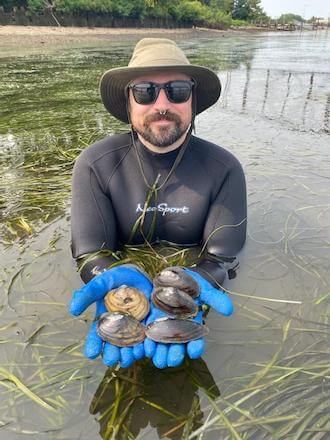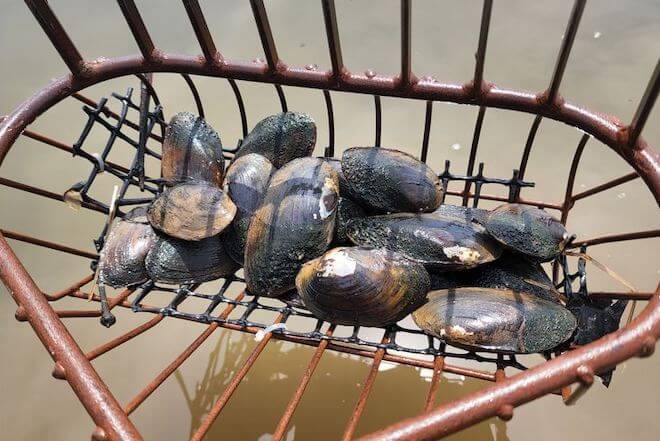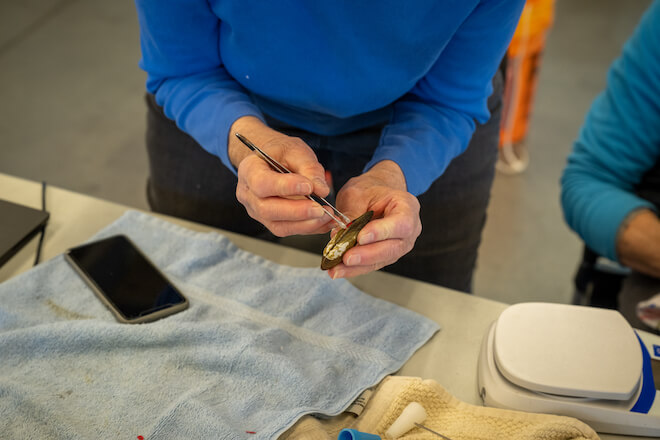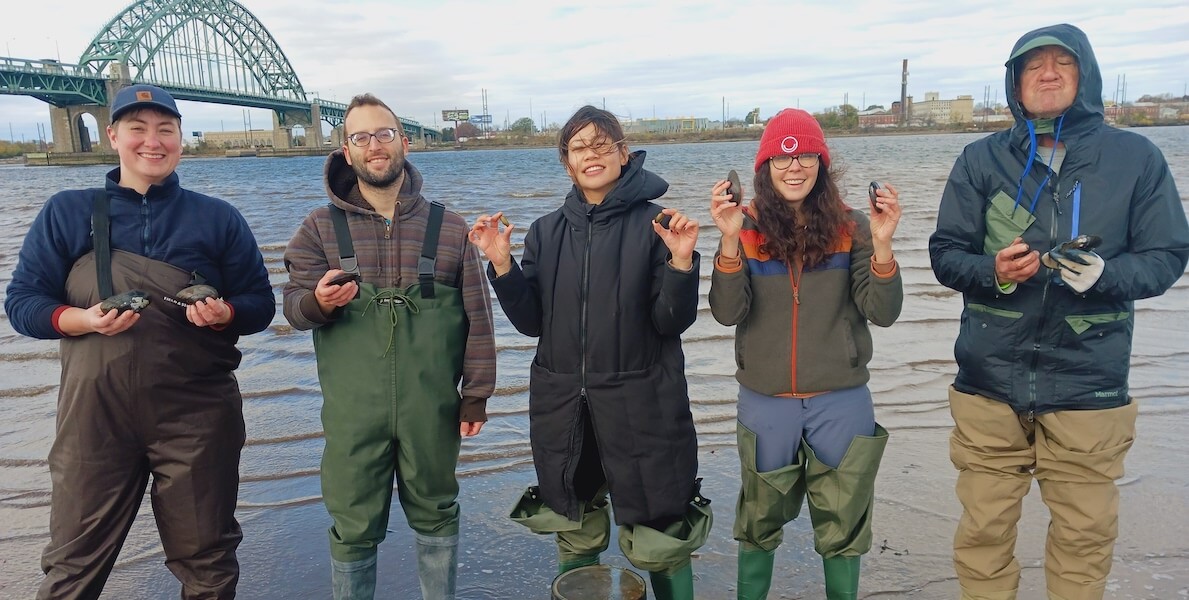Looking through a microscope, Lance Butler, senior scientist with the Philadelphia Water Department, observes a cluster of juvenile mussels.
The bivalves, no bigger than a grain of sand, open and close their shells around algae. Nearby, Butler’s colleague Matt Gentry, shellfish coordinator with the Partnership for the Delaware Estuary (PDE), uses a pipette to place a few of the creatures into a tank of water with 200 to 300 of their siblings and cousins.
These mussels weren’t pulled from the ocean. They’re a freshwater species. Nor were they gathered from the beds of the nearby Delaware or Schuylkill Rivers. See, Gentry and Butler aren’t just studying these mussels. They’re propagating them, working to breed and raise them in a lab.
In the basement of the Fairmount Water Works, the duo are working to raise common species of mussels, in an effort to repopulate local waterways with bivalves that can filter out pollutants and make the water safer to drink.
“All the struggles to build this in Southwest Philly are a bit frustrating. I’m a scientist, so I just want to do fun stuff and so much of my time is spent with lawyers and trying to fundraise.” — Danielle Kreeger
Since opening the hatchery in Fairmount Water Works in 2017, scientists have produced and released 30,000 mussels. They’ve also worked with the U.S. Fish and Wildlife Service to propagate and place over 250,000 additional mussels for research and placement in our waterways.
Next year, PDE is planning to take on an even more ambitious effort: breaking ground on a second, 8,000-square-foot hatchery at Bartram’s Garden that — if all goes according to plan — will produce half a million mussels each year to purify the Susquehanna, Schuylkill and Delaware rivers.
What happened to our mussels?
PDE first developed its mussel strategy in 2007, back when few in the region believed there were any of the animals left in the watershed. “If you would’ve said to me [10 years ago] that we had freshwater mussels in the Philadelphia region, I would’ve said: ‘You’re full of it,’” Butler recalls. “I would’ve said, ‘No, I don’t believe you.’”
Like many species, freshwater mussels were a casualty of the industrial revolution. As factories sprouted up along the Schuylkill, people built dams to power them, which hindered bivalve reproduction. During the larval stage, baby mussels attach themselves to the gills of fish. They stay there as their organs grow until they’re big enough to survive on their own. But the dams prevented fish hosts from migrating. No hosts: No mussels.

At the same time, industrialists were raking mussels from the rivers. Buttonmakers prized their pearlescent shells, and the ecosystem at the bottom of Philly’s rivers went from one teeming with life — picture schools of fish traversing aquatic grasses and mussel beds — to one dominated by mud. Lots of mud.
“There’s very few mussels, very few wetlands, very little submerged grasses,” says Dr. Danielle Kreeger, PDE’s senior science director.
Despite depleted populations, mussels still provide a critical service in our waterways. A single freshwater mussel can filter up to 15 gallons of water each day, removing pollutants like nitrogen, bacteria and some metals. Bivalves clear mud from estuaries, allowing sunlight to reach aquatic grasses deeper into the water. “If it can live 80 to a 100 years, that’s an incredible amount of water filtered for free over their lifetime,” says Elizabeth Horsey, development director for PDE. [Editor’s note: The lifespan of a freshwater mussel is decades.]
So when volunteers from PDE found mussels still living in the watershed, Kreeger knew she wanted to restore the population. Scientists obtained funding for an educational hatchery at Fairmount Water Works between 2014 and 2015 and began the process of breeding mussels.
Other states already have mollusk propagation efforts underway, often through universities, nonprofits and other laboratories. The Billion Oyster Project is working to restore oyster populations in New York Harbor. Local groups and aquariums are producing and releasing freshwater mussels to revive local waterways in and around Chicago.
Many of the efforts are targeted toward endangered species, however. Kreeger says PDE’s efforts are unique because they target common species. The Fairmount lab currently produces five species that create thick, healthy beds, which improve overall ecosystem health and increase their water purifying effects. They’re focused on restoring mussel beds in response to the Clean Water Act, not the Endangered Species Act.
“Our primary goal with this program is to promote cleaner water by promoting natural infrastructure and natural habitats,” Kreeger says. “We can’t just focus on rare species.”
In 2018, PDE, alongside the Philadelphia Water Department, the Department of Parks and Recreation, Drexel University’s College of Arts and Sciences, The Academy of Natural Sciences of Drexel University, Audubon Mid-Atlantic and the John Bartram Association, formed the Aquatic Research and Restoration Center (ARRC), a group dedicated to restoring the region’s mussel beds.
How does mussel propagation work?
Back in the Water Works lab, dozens of largemouth bass no bigger than an index finger swim inside a water tank, waiting to be introduced to the female mussels in order to begin the propagation process.
Butler, Gentry and the other scientists working in the hatchery often collect broodstock for propagation from the Delaware River in February and March. Sporting waders, they scrape mussels from their beds using a clam rake.
Once the breed stock arrives at the lab, they go into temperature-controlled tanks to prevent them from spawning. Scientists then introduce them to the fish, warm the water, and allow the breeding to begin. After the glochidia, the scientific name for the larval stage of mussel development, embed in the fish gills, they move to one of several green tanks — Butler calls them the lab’s “Hilton Hotel” — to wait for the juvenile mussels to drop off. A single host fish can carry as many as 200 glochidia, though this, too, is species-dependent.

The mussels then move through a series of tanks, each designed to help them reach the next stage of growth, until they’re ready to move to one of the project’s nursery ponds. At this point, the bivalves are 40 to 60 millimeters long. These ponds, found at the Green Lane Reservoir, Winterthur Museum, Garden and Library, the Discovery Center, and several stormwater ponds in New Castle County, Delaware, offer a semi-controlled environment for the mussels to continue growing. Horsey likens the transition to a human child going into daycare. There are currently about 70,000 mussels across the pond sites.
A single mussel can produce massive amounts of glochidia. Butler estimated that anywhere from 50,000 to 200,000 was reasonable, but many of them die during the breeding and maturation process. In the wild, one out of every 10,000 survives, he says. In a lab environment, 40 percent survive.
“In those ponds, we’ll have them contained and baby them a little bit, and make sure that they are growing healthy and fast,” she says. “But also it hardens them to natural conditions, because when they’re in a controlled hatchery environment, it just isn’t going to prepare them for what it’s like out in the wild.”
A bigger, better hatchery
The hatchery at the Fairmount Water Works is a start, but it’s largely for education. The site can’t produce the massive amounts of mussels needed to repopulate the waterways in the Delaware River basin.
In 2018, PDE had an opportunity to take its mussel restoration efforts to the next level. PennVEST, an organization that provides funding for stormwater and drinking water projects, awarded them a $7.9 million grant to bring a hatchery to the region. They considered a number of sites both inside and out of Philly, and selected Bartram’s Garden, in part for its proximity to the tidal portion of the Schuylkill River. Once the site is operational, they’ll be able to raise half a million mussels per year to help repopulate the Susquehanna and Delaware River watersheds.
“Once people know about freshwater mussels, they just become so enthusiastic about them,” — Elizabeth Horsey.
The process of building the new hatchery has been slow. PDE spent a year working to secure the grant from PennVEST, then had to negotiate a 30-year lease with the City, which owns Bartram’s garden. (PDE will own the hatchery building per a requirement of the PennVEST funding, but the City still owns the ground under it.) Covid delayed all of these negotiations. Then Hurricane Ida hit, decimating the lab at Fairmount Water Works. ARRC scientists had to make do with a “bubblegum and duct tape type of laboratory,” Butler says, while repairs were made.
“All the struggles to build this in Southwest Philly are a bit frustrating,” Kreeger says. “I’m a scientist, so I just want to do fun stuff and so much of my time is spent with lawyers and trying to fundraise.”
These complications means the $7.9 million PDE thought would be enough to build a hatchery in 2018 is no longer adequate. Pandemic-related supply chain issues have driven up the cost of building materials. “Those costs have doubled from where we thought they were in 2016 and 2017, which was when we mapped out the budget,” Kreeger says.
The project has received an additional $1 million in congressionally directed spending supported by Senators Chirs Coons and Tom Carper from Delaware and Sen. Bob Casey from Pennsylvania, along with grants from various organizations. But they’re still fundraising to cover about a $3 million shortfall. If all goes well, construction will begin in summer or fall of 2024, and PDE will complete the hatchery in 2026. The project design includes a 12,000-square-foot educational center and atrium for the public, in addition to the 8,000 square feet of lab space.

Combining science and watershed education
On a crisp, cool winter day, Bria Wimberly, senior coordinator of conservation education with the National Audubon Society, gathered with a group of volunteers on the docks of the Discovery Center and released a cage full of mussels back into the Strawberry Mansion Reservoir.
All morning, the group of about 15 had sat in one of the Discovery Center’s classrooms, adjusting caliper jaws to measure the thickness of 800 of the adult mussels maturing in the reservoir. Volunteers attach red tags to the shells of mussels that grow large enough — about an inch and a half. Then, scientists from ARRC collect them to place in one of the sites within the Delaware Watershed where the group is trying to restore bivalve beds. The Discovery Center has tagged between 700 and 800 mussels so far.
The event, which Wimberly calls “Mussel Maniacs,” has two purposes: Help scientists monitor the growth of the mussels propagated in the Water Works hatchery, and educate community members about their local watershed. Teaching Philadelphians about their watershed has been key to ARRC’s mission since the hatchery at Water Works opened. Science educators working with the project hope it will equip folks to make decisions about the safety and quality of their drinking water and teach people the value of conserving our river ecosystems.
“There are some times where I will chat with students, and they’ll say I didn’t realize how our water comes from two different sites, the Delaware River and the Schuylkill River,” Wimberly says.
Hands-on, real-world education with clear links to the watershed’s impacts is part of what PDE’s mussel hatchery at Bartram’s Garden is trying to achieve. The site will host Bartram’s Garden’s educational programming, where students from schools across the city come in with their science courses to learn about the city’s ecosystems and watershed. It’ll also serve as a space that can host community events, like free yoga classes or baby showers.
The folks at PDE hope the public gets excited about restoring mussel beds, too: “Once people know about freshwater mussels, they just become so enthusiastic about them,” Horsey says.
Correction: The first name of Philadelphia Water Department Senior Scientist was misspelled in a previous post. His correct name is Lance Butler.
![]() MORE ON CLEANING UP THE ENVIRONMENT FROM THE CITIZEN
MORE ON CLEANING UP THE ENVIRONMENT FROM THE CITIZEN





